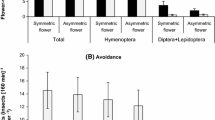Abstract
Size and species composition of flower patches were manipulated to determine whether these factors exerted indirect effects on the hunting success of flower-dwelling spiders via direct effects on insect pollinators. Multivariate analysis of variance (MANOVA) of two pollinator response variables (visitation rate and visitor size) revealed a significant pollinator preference for Bidens aristosa (tickseed sunflower) over Solidago juncea (goldenrod) and for large patches of a given plant species over small patches. Bidens received significantly more pollinator visits per floral unit per unit time and attracted significantly larger insects than Solidago. The significant patch size effect seen in the MANOVA was driven by the strong impact of patch size on the size of insects visiting the experimental patches: the size (mass) of insects visiting large patches was significantly greater than the size of insects visiting small patches of a given plant species, but visitation rates to large and small patches of a given plant species were similar. MANOVA indicated that hunting success of a flower-dwelling crab spider, Misumenoides formosipes, was also significantly affected by species composition and size of flower patches. Three measures of spider hunting success (rate of mass gain and its components, total prey mass captured per spider per day, and number of prey captured per spider per day) were evaluated, and the experimental treatments exerted similar effects on all three measures. Spiders occupying Bidens patches experienced greater hunting success than spiders occupying Solidago patches, and in patches of a given plant species, spiders occupying large patches experienced greater hunting success than spiders occupying small patches. The pattern of spider hunting success most closely paralleled the pattern described by the size of insects visiting the patches (BL>BS=SL>SS), suggesting that the size of visiting pollinators, rather than frequency of visitation, exerted a greater influence on spider hunting success. Taxonomic composition of a spider's diet varied with the plant species occupied. The size of insects captured by spiders was significantly greater than average size of insects visiting the patches, indicating that spiders selectively captured larger pollinator taxa. Spider movements among patches revealed a pattern of migration from Solidago to Bidens.
Similar content being viewed by others
Author information
Authors and Affiliations
Additional information
Electronic Publication
Rights and permissions
About this article
Cite this article
Schmalhofer, V.R. Tritrophic interactions in a pollination system: impacts of species composition and size of flower patches on the hunting success of a flower-dwelling spider. Oecologia 129, 292–303 (2001). https://doi.org/10.1007/s004420100726
Received:
Accepted:
Published:
Issue Date:
DOI: https://doi.org/10.1007/s004420100726




